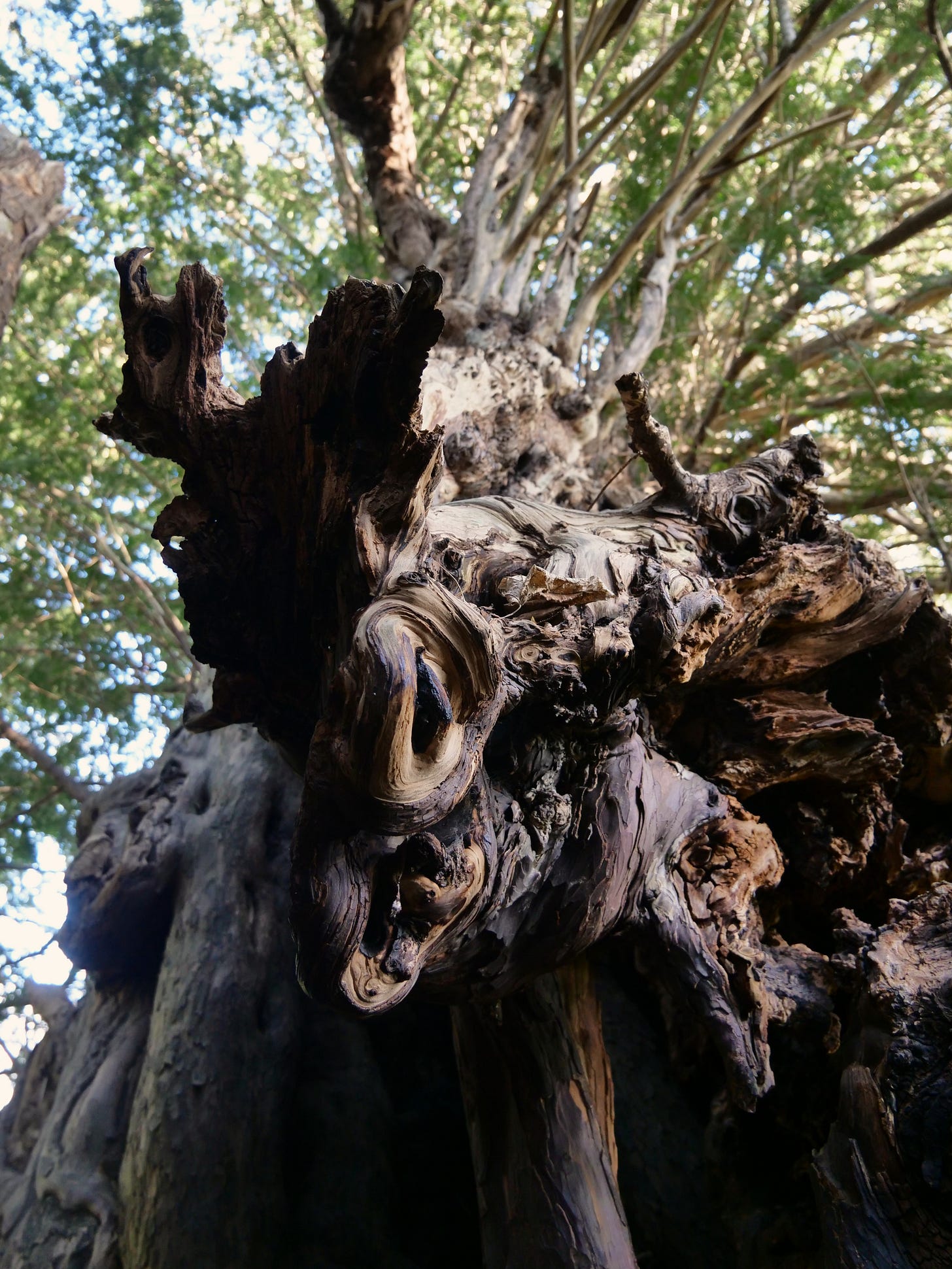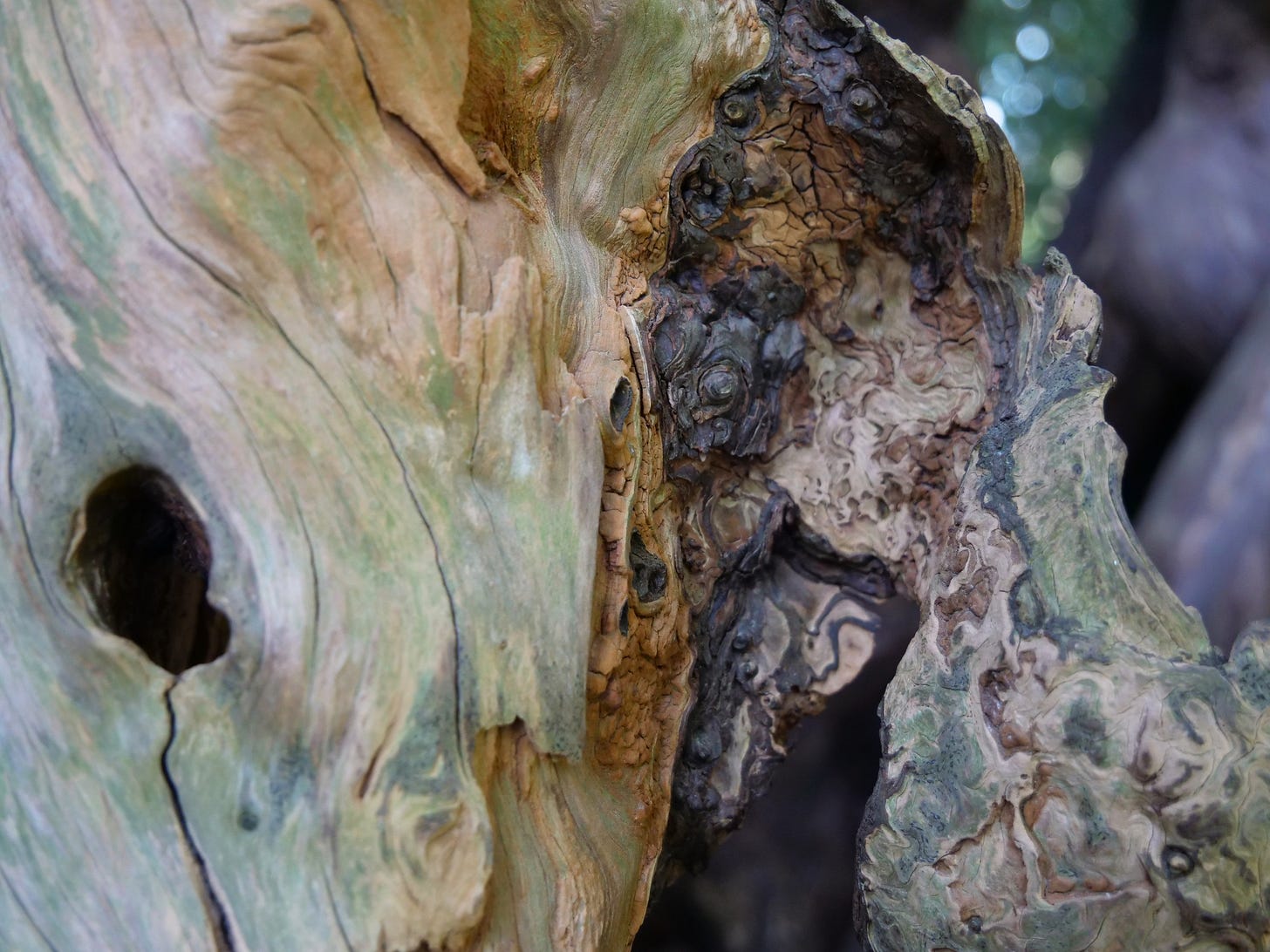“Are you looking for Ankerwycke?”, asks a woman excitedly. She has spotted us loitering under a nearby poplar tree and wandered over to greet us. “It’s up there, straight over the bridge, but you have to get under the canopy to see it properly.”
You do indeed have to get under the canopy to see it properly. Passing through the grounds of Ankerwycke without paying much attention to the signposts or the information boards, you would be forgiven for missing it entirely. This ancient tree, said to be around 2,500 years old, is outwardly unremarkable. It lurks awkwardly in the background, its branches fading into the leaves of a neighbouring yew.
“Is that it?”, I ask Katja.
“I think so,” she says, unsure. “Let’s get closer.”
Stepping onto Magna Carta Island is like stepping back in time. Ankerwycke is positioned right next to Heathrow Airport. Planes fly though the sky, the sound of the motorway is never far away. And yet, despite the noise, something feels different here. Cut out from the rest of the land, this island is its own place. Its own kingdom. This is a land of grass, of mud, of trees. Ruins rise out of the ground. Red kites circle overhead.
We cross the river and walk tentatively towards the tree.
As we do so, I realise I am no longer so excited. It seems obvious now that it will be a disappointment. The Ankerwycke Yew teeters, lopsided, towards the river bank, unable to frame itself against the wind. It is disappointingly normal.
“The woman said we have to get under the canopy” Katja reminds me.
“I know”, I say, unconvinced.
Undeterred, Katja pulls one of the branches back like a curtain. I crouch down and pass through. For a moment, all I can see is soil and sticks. I blink. When I look up, I am standing in a different world.
Under the canopy of the Ankerwycke Yew is a split trunk and a maze of twisted branches, all jumbled and sprawling. In passages, the wood seems to flow like water. Meandering, surging, cascading into the hollow. In others, the bark is rough and splintered. This is a world of dappled light, of wooden peaks, of variegated bark.
“What’s it like?” asks Katja.
I am too stunned to speak.
The Ankerwycke Yew is where it all started. According to local legend, it was here that King John signed the first draft of the Magna Carta, surrounded by a coterie of nervous courtiers and a crowd of rebellious barons. It was here too, they claim, that Henry VIII first courted Anne Boleyn. “What scenes have pass’d”, wrote the poet William Thomas Fitzgerald in 1807, “since first this ancient Yew in all the strength of youthful beauty grew!” What scenes, indeed? There are traces of Bronze Age settlements at Ankerwycke and Neolithic structures have been discovered nearby. There is also evidence of two bridges built during Roman times; this area was called “Ad Pontes” back then, meaning “At the Bridges”.
Long before the signing of the Magna Carta, ancient councils gathered in the open fields here. The Witan, a council of noblemen who advised Anglo-Saxon kings, occasionally met here during the reign of Alfred the Great. Allen Meredith, an environmentalist and a former soldier, goes one step further. He argues that before the Norman Conquest many English kings were inaugurated under the Ankerwycke Yew. Apparently, this vision came to him in a dream. “One tree can become a forest,” Meredith wrote. “Please let it begin at Ankerwycke.” On the other side of the river is a water meadow named Runnymede which was another regular meeting place; its own name comes from the Middle English, meaning “the meadow for taking counsel”. Some people believe that the course of the river has altered over the centuries and that the area around the Ankerwycke Yew was originally a part of Runnymede. Others, like Meredith, believe that the area was only ever considered special because of the yew. “There would be no Runnymede, no Magna Carta, if the tree had not been there,” he wrote.
In Celtic folklore, the branches of a yew tree are portals to another world. And, under the canopy of the Ankerwycke Yew, it is easy to understand why. The bark of the yew is bright green, deep purple, a dark, oily black. Colours coagulate, undulate, swirl and ripple across the length of the tree. Faces appear in the eddies. Scaly, smooth, cumbersome and flighty. The Ankerwycke Yew is startlingly alive.
“Look”, says Katja, now beside me.
She is pointing at a scrap of cloth.
We walk around the trunk of the tree and notice that there are many bits of string tied to its branches. Ribbons. Pieces of fabric. A purple, Primark tie. These offerings would once have been called “clooties.” People would hang them at sacred places, make a wish and, as the rags decayed, their prayers would be answered. That this ancient practise still continues today feels like another kind of magic.
“What do you think they’re all wishing for?”, asks Katja.
The new name - Ankerwycke - is thought to come from the anchorites who once lived here, a small community of religious women who locked themselves in isolated cells in the hope of becoming living saints. Did the nuns here also believe in the sacred powers of the Ankerwycke Yew? Did they look at the clooties, swaying in the wind, and feel jealous? This particular group of anchorites were a little more rebellious than the usual fare. In the twelfth century, one woman ran away from the priory at Ankerwycke, claiming that her family had trapped her here in order to steal her inheritance; unimpressed, the Pope ordered her back to her cell and the woman was excommunicated. In the fifteenth century, the Bishop of Lincoln reported that the nuns at Ankerwycke were unhappy once again; their dormitory windows had been barricaded shut by the abbess because they kept shouting to men by the riverside. A few decades later, another woman escaped to meet her lover; they were married soon after. Bedevilled by runaway nuns and lusty fishermen, the priory at Ankerwycke admitted defeat and eventually closed.
As the world changed, so too did this little island. In the sixteenth century, Ankerwycke was gifted to a royal adviser; in the nineteenth century, it became the estate of a slave owner; in the twentieth century, it was converted into an elite nightclub, attracting movie stars from the nearby studios at Pinewood and Elstree. When the estate burned down thirty years later, the land was marked for redevelopment and due to be turned into a golf course. A fight ensued. Local campaigners, calling themselves the “Ankerwycke Action Group” and the “Friends of the Ankerwycke Yew”, fought against the planning application and won. The tree was saved and eventually the land fell into the care of the National Trust.
It was so nearly cut down. We so nearly lost it all.
But, luckily, their prayers were answered. A wish fulfilled.
“I don’t want to leave,” I say.
“Neither do I,” says Katja. “But the light is going.”
As we pass back under the branches of the Ankerwycke Yew, I am left with an immense feeling of gratitude. So what if this ancient tree is not outwardly spectacular? Its inner world is miraculous. These trees have weathered countless storms, survived a thousand floods, sprung fresh flowers year after year. They have lived on this planet far longer than us. Is that not enough to deserve our respect? Our awe? The Ankerwycke Yew is important in and of itself, regardless of its effect on us or its relationship to human history. There is magic here, and we would do well to remember that.
The historian Samuel Thorne has described the history of the Magna Carta as a “long and disorderly jumble”. So then is the history of the Ankerwycke Yew. Knotted and twisted, the roots of the yew serve as a testament to this. These ancient roots have grown alongside our history, our laws, our fledgling democracy. Yew trees are sometimes called “phoenix trees” because of their amazing ability to regenerate. When the trunk becomes hollow, yews can produce new roots that grow within the shell of the original. They also do something called “layering”, a process by which new roots are grown from branches breaking off and burrowing deep undergound. New buds sprout from beneath the bark and, over the centuries, the tree creeps along the ground like a crab. Hypothetically, an old yew can trace its ancestry back hundreds of millions of years. “Our yew tree is not only a descendant of the primordial forests that recolonised Britain after the last ice age,” write the National Trust of the Ankerwycke Yew, “but it may in fact be one and the same entity, renewed through natural cloning.”
It is a strangely comforting thought.
As we walk home, I realise that I am now looking at the world differently. I am walking with a sense of wonder. I am gazing at the most ordinary things with the upmost reverie. A snapped twig. A heap of leaves. A weed between the paving stones. Every tree we pass seems to harbour a thousand secrets, a thousand stories, a thousand private wishes.
Every fallen trunk, every tiny shrub. I look at them now and wonder. What other worlds exist beneath those branches?
Some more photos of the Ankerwycke Yew:

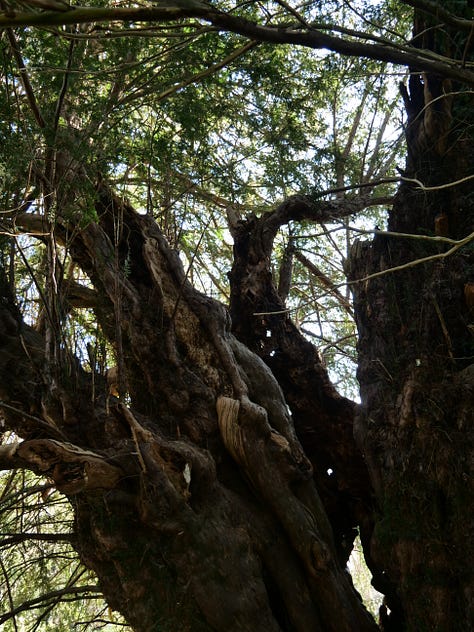

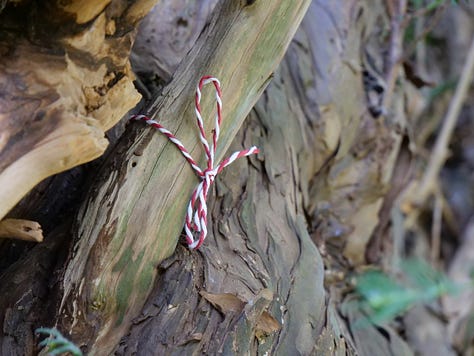
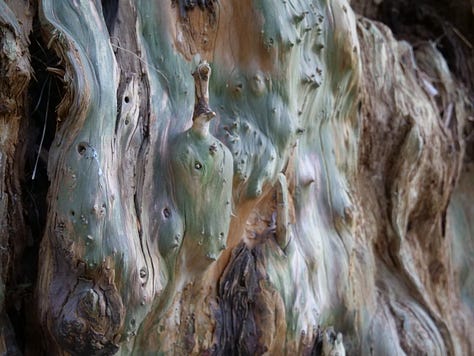
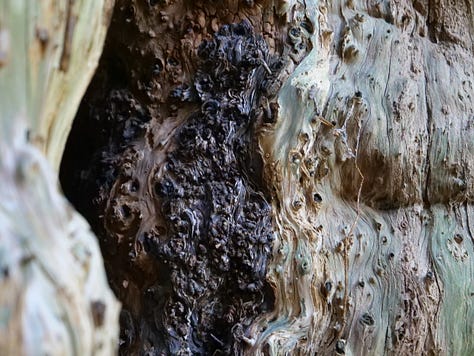
Some more photos from our walk:
Over the course of many years, I am hoping to visit all fifty trees on the Tree Council’s list of Great British Trees. This is the first… Thanks for reading. Much love to everyone resisting fossil capitalism whoever and wherever you are.




